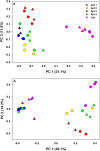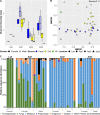Overlapping Community Compositions of Gut and Fecal Microbiomes in Lab-Reared and Field-Collected German Cockroaches
- PMID: 29959246
- PMCID: PMC6102980
- DOI: 10.1128/AEM.01037-18
Overlapping Community Compositions of Gut and Fecal Microbiomes in Lab-Reared and Field-Collected German Cockroaches
Abstract
German cockroaches, Blattella germanica (Blattodea: Ectobiidae), are human commensals that move freely between food and waste, disseminating bacteria, including potential pathogens, through their feces. However, the relationship between the microbial communities of the cockroach gut and feces is poorly understood. We analyzed the V4 region of the 16S rRNA gene and the V9 region of the 18S rRNA gene by next-generation sequencing (NGS) to compare the bacterial and protist diversities in guts versus feces and males versus females, as well as assess variation across cockroach populations. Cockroaches harbored a diverse array of bacteria, and 80 to 90% of the operational taxonomic units (OTUs) were shared between the feces and gut. Lab-reared and field-collected cockroaches had distinct microbiota, and whereas lab-reared cockroaches had relatively conserved communities, considerable variation was observed in the microbial community composition of cockroaches collected in different apartments. Nonetheless, cockroaches from all locations shared some core bacterial taxa. The eukaryotic community in the feces of field-collected cockroaches was found to be more diverse than that in lab-reared cockroaches. These results demonstrate that cockroaches disseminate their gut microbiome in their feces, and they underscore the important contribution of the cockroach fecal microbiome to the microbial diversity of cockroach-infested homes.IMPORTANCE The German cockroach infests diverse human-built structures, including homes and hospitals. It produces potent allergens that trigger asthma and disseminates opportunistic pathogens in its feces. A comprehensive understanding of gut and fecal microbial communities of cockroaches is essential not only to understand their contribution to the biology of the cockroach, but also for exploring their clinical relevance. In this study, we compare the diversity of bacteria and eukaryotes in the cockroach gut and feces and assess the variation in the gut microbiota across cockroach populations.
Keywords: Blattella microbiota; German cockroach; fecal microbiota; feces; gut; indoor microbiome; microbiome.
Copyright © 2018 Kakumanu et al.
Figures








Similar articles
-
The Core Gut Microbiome of the American Cockroach, Periplaneta americana, Is Stable and Resilient to Dietary Shifts.Appl Environ Microbiol. 2016 Oct 27;82(22):6603-6610. doi: 10.1128/AEM.01837-16. Print 2016 Nov 15. Appl Environ Microbiol. 2016. PMID: 27590811 Free PMC article.
-
Diet shapes the gut microbiota of the omnivorous cockroach Blattella germanica.FEMS Microbiol Ecol. 2015 Apr;91(4):fiv022. doi: 10.1093/femsec/fiv022. Epub 2015 Feb 26. FEMS Microbiol Ecol. 2015. PMID: 25764470
-
Adaptability of the gut microbiota of the German cockroach Blattella germanica to a periodic antibiotic treatment.Microbiol Res. 2024 Oct;287:127863. doi: 10.1016/j.micres.2024.127863. Epub 2024 Aug 3. Microbiol Res. 2024. PMID: 39106785
-
Bacteria associated with cockroaches: health risk or biotechnological opportunity?Appl Microbiol Biotechnol. 2020 Dec;104(24):10369-10387. doi: 10.1007/s00253-020-10973-6. Epub 2020 Oct 31. Appl Microbiol Biotechnol. 2020. PMID: 33128616 Free PMC article. Review.
-
Contamination of Cockroaches (Insecta: Blattaria) by Medically Important Bacteriae: A Systematic Review and Meta-analysis.J Med Entomol. 2019 Oct 28;56(6):1534-1554. doi: 10.1093/jme/tjz095. J Med Entomol. 2019. PMID: 31219601
Cited by
-
Exposure to a fungicide for a field-realistic duration does not alter bumble bee fecal microbiota structure.Appl Environ Microbiol. 2024 Feb 21;90(2):e0173923. doi: 10.1128/aem.01739-23. Epub 2024 Jan 19. Appl Environ Microbiol. 2024. PMID: 38240563 Free PMC article.
-
The effects of taxonomy, diet, and ecology on the microbiota of riverine macroinvertebrates.Ecol Evol. 2020 Nov 18;10(24):14000-14019. doi: 10.1002/ece3.6993. eCollection 2020 Dec. Ecol Evol. 2020. PMID: 33391698 Free PMC article.
-
Antimicrobial peptide expression in the cockroach gut during enterobacterial infection is specific and influenced by type III secretion.Biol Open. 2022 May 15;11(5):bio059414. doi: 10.1242/bio.059414. Epub 2022 May 25. Biol Open. 2022. PMID: 35611712 Free PMC article.
-
Insects, Rodents, and Pets as Reservoirs, Vectors, and Sentinels of Antimicrobial Resistance.Antibiotics (Basel). 2021 Jan 12;10(1):68. doi: 10.3390/antibiotics10010068. Antibiotics (Basel). 2021. PMID: 33445633 Free PMC article. Review.
-
The gut microbiota confers resistance against Salmonella Typhimurium in cockroaches by modulating innate immunity.iScience. 2024 Oct 30;27(12):111293. doi: 10.1016/j.isci.2024.111293. eCollection 2024 Dec 20. iScience. 2024. PMID: 39628558 Free PMC article.
References
-
- Bell WJ, Roth LM, Nalepa CA. 2007. Cockroaches: ecology, behavior, and natural history. Johns Hopkins University Press, Baltimore, MD.
-
- Schal C, Gautier JY, Bell WJ. 1984. Behavioral ecology of cockroaches. Biol Rev Camb Philos Soc 59:209–254. doi:10.1111/j.1469-185X.1984.tb00408.x. - DOI
-
- Brooks MA. 1970. Comments on the classification of intracellular symbiotes of cockroaches and a description of the species. J Invertebr Pathol 16:249–258. doi:10.1016/0022-2011(70)90066-2. - DOI
-
- Mullins DE, Cochran DG. 1974. Nitrogen metabolism in the American cockroach: an examination of whole body and fat body regulation of cations in response to nitrogen balance. J Exp Biol 61:557–570. - PubMed
Publication types
MeSH terms
Substances
Grants and funding
LinkOut - more resources
Full Text Sources
Other Literature Sources
Miscellaneous

